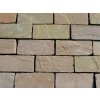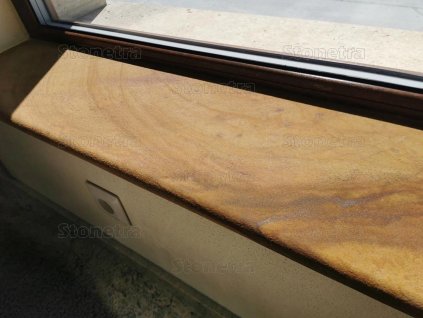Sandstone
Sandstone is a natural sedimentary stone composed mainly of sand-sized mineral particles, typically quartz or feldspar. It is valued for its earthy colors—ranging from soft beige, cream, and gold to reddish-brown and grey—and its natural texture, making it a versatile and aesthetically appealing material for construction and decoration.
Sandstone has a long and storied history in architecture. Many ancient civilizations used sandstone due to its abundance and workability. Iconic structures such as the Red Fort in India, the Petra city facades in Jordan, and numerous European cathedrals and castles showcase sandstone’s durability and beauty. It has been used for centuries in walls, temples, bridges, and monuments.
Modern Uses
Sandstone continues to be a popular natural stone for both interior and exterior applications:
- Flooring: slabs for outdoor spaces.
- Wall Cladding: accent walls, fireplaces, TV walls
- Stone facade: rock stone veneer.
- Paving: Terraces, rock walkways, patios, pool coping, cobblestone driveway.
- Decorative Elements: garden ending, big stones for landscaping, Sandstone Desert Rose.
-
Squares and roads: pedestrina zone, streets, parking lot, historical center
Its natural texture and color variations allow it to complement both modern and traditional designs.
Available sizes
- Stone cladding strips: 30 cm x 7.5 cm
- Driveway and walkway pavers: 20 cm x 10 cm
- Patio pavers: Roman pattern and 90 cm x 60 cm
-
Pool coping, window sills, steps: 100 cm x 25 cm
Qualities
- Durable: Strong and resistant to weathering, suitable for outdoor applications.
- Natural Beauty: Unique patterns and earthy tones add warmth and elegance.
- Eco-Friendly: Natural stone that does not emit harmful chemicals.
- Workability: Can be cut, shaped, and finished for a wide variety of applications.
- Versatility: Works well with wood, metal, glass, and other natural stones.
Care and Maintenance
Proper care ensures sandstone maintains its natural beauty and longevity:
- Sealing: Should be sealed upon installation and periodically resealed to prevent staining and water penetration.
- Cleaning: Use pH-neutral cleaners; avoid acidic or abrasive products that may damage the surface.
- Spill Management: Wipe up spills immediately to prevent staining, particularly from oils or acidic substances.
- Protection: Use mats, rugs, or pads under furniture to prevent scratches.
- Polished Surfaces: Require gentle cleaning and occasional polishing to maintain shine.
- Outdoor Use: Regular cleaning and proper drainage help prevent moss, algae, or dirt buildup.
Sandstone combines natural beauty, durability, versatility, and historical significance. From ancient monuments to modern architecture, it remains a timeless material appreciated for its earthy tones, wide range of surface treatments, and enduring qualities.






































